Abstract
The materials currently used for bone prostheses are mainly metals such as titanium alloy. Compared with human cortical bone, traditional metals exhibit high elastic moduli, which may lead to stress shielding. In contrast, the mechanical strength and elastic modulus of polyetheretherketone are slightly lower than those of human bone. In this study, we utilize multi-component co-modification in order to improve the mechanical properties of polyetheretherketone materials. Firstly, we blended three types of materials: multi-walled carbon nanotubes, nanohydroxyapatite, and carbon fibers. Then, the blended materials were used to reinforce polyetheretherketone, and the preparation of the multi-walled carbon nanotubes/nanohydroxyapatite/carbon fibers was described in detail. After the contact angle was determined, SEM, thermogravimetric analysis, and various tests were conducted on the ternary composites. Ball milling co-mingling technology was used to prepare tetrad composite specimens for tensile and compression experiments, a finite element model of the tetrad composite tensile and compression specimens was established, and the structural stresses of the specimens were analyzed under the specified loads. The experimental results show that the surface roughness of carbon fiber increased, and the multi-walled carbon nanotube/nanohydroxyapatite/carbon fiber/polyetheretherketone quaternary composites were well optimized in terms of strength and elastic modulus, which broadens the application field of polyetheretherketone materials.
1. Introduction
Polyetheretherketone (PEEK) is a high-performance engineering plastic that is chemically stable, heat-resistant, biocompatible with human tissues, and highly resistant to abrasion, which has led to its widespread use in medical devices, orthopedic implants, and dental applications [1,2]. In addition, PEEK is transparent in X-rays, which makes it ideal for radiolucent instruments and components. Taken together, PEEK materials have a variety of excellent properties that make them promising for use in a wide range of applications in the medical field. However, the mechanical strength and elastic modulus of polyetheretherketone materials are relatively low, and they can only be used in human bone with low elastic moduli and low strength requirements [3]. Therefore, it is necessary to further improve the biomechanical properties of PEEK to expand its application in load-bearing regions of the bone.
The best way to achieve this is through filler modification, whereby adding fillers to PEEK can improve its mechanical properties (e.g., tensile, compressive, flexural strength, modulus, and toughness). Materials that are commonly used in filler-modified polyetheretherketone fillers include carbon fibers, metal oxides, carbon nanotubes, graphene oxide, and multi-component composites [4,5,6].
Carbon fiber (CF) exhibits excellent mechanical properties, chemical stability, a very light weight, high stiffness values, and high levels of temperature resistance, among other properties. When polyetheretherketone (PEEK) is combined with carbon fiber, the overall mechanical properties of the composites can be effectively enhanced [7]. Three main factors affect the mechanical properties of PEEK/CF: the proportion of CF that is added, the length of the CF, and the interfacial interaction between CF and polyetheretherketone [8]. Qin et al. [9] successfully prepared a series of CF/PEEK composites with different carbon fiber contents. The test results showed that, at a carbon fiber content of 40%, the CF/PEEK flexural strength, flexural modulus compressive strength, and compressive modulus reached the optimum, which provided a basis for further research on CF/PEEK composites as orthopedic and implant materials. Zhou et al. [10] prepared continuous carbon-fiber-reinforced polyetheretherketone (CCF/PEEK). Short-cut carbon-fiber-reinforced polyetheretherketone (SCF/PEEK) and mechanical experiments led to the conclusion that CCF/PEEK is stronger than SCF/PEEK and pure PEEK in terms of tensile strength, bending strength, and flexural modulus, as well as being more suitable for applications in which higher strength is required. However, short-cut carbon fiber (SCF) is much cheaper than continuous CF, and PEEK/SCF composites can be easily fabricated using conventional extrusion and injection molding techniques; PEEK composites may offer a non-metallic alternative to titanium and a prospective material in bone tissue engineering. Hassan et al. [11] added polyetherketoneketone (PEKK) to the surface of activated carbon fibers, and it was experimentally shown that the interlaminar shear strength, flexural strength, and modulus were increased by 70%, 37%, and 48%, respectively. Qin et al. [12] grafted amine-based graphene oxide onto oxidized CF to prepare CF/PEEK implants. The dispersion of CF in the composites was significantly improved. The flexural strength, compressive strength, and hardness of CF/PEEK were increased by 51%, 46%, and 30%, respectively; CF/PEEK composites with the dual functions of mechanical reinforcement and osseointegration facilitation have excellent potential for orthopedic/dental applications.
Metal-oxide-reinforced polyetheretherketone (PEEK) is a plastic commonly used in high-temperature and high-strength applications. Adding metal oxides can improve various properties of PEEK, such as enhancing its thermal conductivity and wear resistance. Some common metal oxides include aluminum oxide, titanium oxide, and zirconium oxide [13,14]. These additions can improve the mechanical properties of polyetheretherketone and make it more suitable for various engineering applications. Díez-Pascual et al. [15] prepared polyetheretherketone (PEEK) nanocomposites with different contents of zinc oxide nanoparticles. It was determined that the Young’s modulus was enhanced by 9% and tensile strength by about 4.6% when using 2.5% zinc oxide nanoparticles. However, when using 7.5% zinc oxide nanoparticles, the Young’s modulus and tensile strength were gradually decreased and were not as good as those of unfilled PEEK.
Carbon nanotubes (CNTs) were blended with PEEK to form composites. The high strength and stiffness of carbon nanotubes can significantly enhance the mechanical properties of PEEK, such as its strength, stiffness, and wear resistance [16]. Carbon nanotubes can establish a mesh structure in the PEEK matrix, which effectively prevents crack extension and, thus, enhances the tensile and flexural properties of the material [17]. Khallaf et al. [18] prepared a PC5 (PEEK-5% MWCNTs) composite by adding 5% MWCNT to PEEK material; the flexural strength was enhanced from 130.16 MPa to 181.30 MPa for the polyetheretherketone material, representing an increase of 39.29%. Therefore, the use of PC5 for low-stress implants has promising application prospects.
The unique structure and properties of graphene oxide can enhance the mechanical strength of polyetheretherketone (PEEK). Graphene oxide is an oxidized graphene derivative with numerous hydroxyl and carboxyl groups as well as other functional groups, which can interact with polyetheretherketone molecules via hydrogen bonding and covalent bonding. Due to the high specific surface area and good mechanical properties of graphene oxide, the addition of it can effectively enhance the mechanical properties of the PEEK matrix [19]. In addition, graphene oxide can improve the thermal stability, abrasion resistance, and chemical resistance of polyetheretherketone. Therefore, graphene oxide composites with polyetheretherketone can significantly improve their overall properties and make them more widely applicable in engineering [20]. Miao et al. [21] prepared graphene oxide (GO)-reinforced PEEK nanocomposites with different graphene oxide loadings. Reinforcement with graphene oxide at 0.5% and 1.0% contents showed the highest flexural strength of 160 MPa (33.33% greater than that of pure PEEK), and the composites’ compressive strength far exceeded that of pure PEEK. Promising strategies have been proposed for preparing PEEK-based composites with excellent biomechanical properties for future hard tissue repair applications.
Multi-component composites are usually made by combining two or more different materials. They are designed to capitalize on the strengths and compensate for the weaknesses of each material. Polyetheretherketone (PEEK) is often used as a matrix material, while other materials, such as carbon fibers, glass fibers, ceramics, hydroxyapatite, and multi-walled carbon nanotubes, are used as reinforcements. This combination produces more robust, more heat- and corrosion-resistant composites, which not only have the advantage of being lightweight but also improve the strength and durability of the material. Deng et al. [22] developed a unique PEEK bioactive ternary composite, PEEK/n-HA/CF. It was found that the elastic modulus of the PEEK/n-HA/CF ternary composite was 16.5 ± 0.7 GPa when the mass ratio of PEEK:n-HA:CF was 55:25:20, which was in the range of 6–30 GPa for human cortical bone, paving the way for PEEK-based ternary composites in many challenging dental and orthopedic applications for bone repair materials.
Ultrasonic treatment is a technology for material treatment that uses ultrasonic waves to propagate and reflect inside the material. Wet blending is a processing method that is usually used in the preparation of powder materials. In this method, the powder material is usually mixed with a liquid or solution and then dried to form the desired product. Ball milling blending is a solid powder mixing technology used to prepare composite materials, alloy powders, etc. In the process of ball milling blending, the powder material is placed in a ball milling tank. Then, the powder is mixed and refined by the rotation and impact of the ball milling medium (usually a metal ball). Through ball milling blending, uniform mixing of powder materials of different components can be achieved, thereby improving the uniformity and stability of the composite material. This occurs because the powder particles are subjected to mechanical force in the ball milling process. The material undergoes high-energy collision and grinding, which can break up micron-level particle agglomeration.
In this study, multi-walled carbon nanotube/hydroxyapatite/carbon fiber (MWCNT/HA/CF) ternary composites were prepared using the wet blending technique. Subsequently, we discussed the changes in the surface morphology as well as the hydrophilicity of the carbon fibers in these composites. Furthermore, we prepared multi-walled carbon nanotube/hydroxyapatite/carbon fiber/polyetheretherketone (MWCNT/HA/CF/PEEK) quaternary composites using the ball milling co-mingling technique to study and compare the mechanical properties of MWCNT/HA/CF/PEEK quaternary composites with those of CF/PEEK and pure PEEK materials. We also investigated the application of the MWCNT/HA/CF/PEEK quaternary composites in load-bearing bone areas. The whole preparation process is shown in Figure 1. For the purposes of this study, the surface energy, wettability, and thermal properties of the MWCNT/HA/CF ternary composites, and the mechanical properties and wettability of the MWCNT/HA/CF/PEEK quaternary composites were investigated.
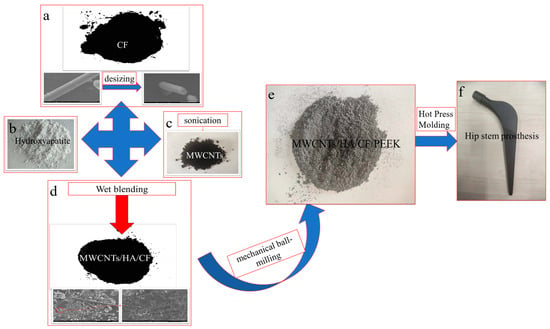
Figure 1.
Material preparation and application. (a) De-sized carbon fiber; (b) hydroxyapatite; (c) ultrasonication of multi-walled carbon nanotubes; (d) preparation of MWCNT/HA/CF ternary composites via wet blending; (e) preparation of MWCNT/HA/CF/PEEK quaternary composites via ball milling blending; (f) quaternary composites for the preparation of prostheses.
2. Materials and Methods
2.1. Main Raw Materials
SL2002N Electronic Balance: Shanghai Minqiao Precision Scientific Instrument Co., Ltd., Shanghai, China; 85-2 Constant Temperature Magnetic Stirrer: Shanghai Silo Instrument Factory, Shanghai, China; UTM5000 Universal Testing Machine: Shenzhen Sanshi Zongheng Technology Co., Shenzhen, China; TA-instrument Q20 DSC Tester: TA Instruments, New Castle, Delaware, USA; DHG-9070A Electric Heating and Constant Temperature Blower Drying Oven: Shanghai Qixin Scientific Instrument Co., Shanghai, China.
2.2. Main Instruments and Equipment
Polyetheretherketone: density, 1.3 g/cm3; particle size, 5~50 μm (UK VICTREX Chemical Co., Ltd., London, UK). Carbon fibers: density, 1.3 g/cm3; diameter, 7 μm (Carbonylene Technology (Shenzhen) Co., Ltd., Shenzhen, China). Multi-walled carbon nanotubes: tube diameter, ≥50 nm; purity, ≥95% (Chengdu Organic Chemistry Company Limited, Chinese Academy of Sciences Co., Ltd., Chengdu, China). Nanohydroxyapatite particles: needle-like; particle size, 5–50 μm (Sigma-Aldrich Chemical Reagent Co., Ltd., Burlington, MA, USA). Anhydrous ethanol: analytically pure (Guangzhou Jinhua Da Chemical Reagent Co., Ltd., Chengdu, China).
2.3. Sample Preparation of Composite Material
2.3.1. Preparation of MWCNT Dispersions
In 500 mL of anhydrous ethanol, 2.00 g of multi-walled carbon nanotubes was added and magnetically stirred to ensure complete wetting, with a stirring time of approximately 30 min. Subsequently, the ultrasonic instrument was used for ultrasonication. The power was set to 300 W, and the ultrasonication time was 60 min. Finally, the degree of dispersion was observed. A few dispersed droplets were added to clear water with a glass rod to observe the dilution state. Well-dispersed carbon nanotubes diffuse quickly and evenly in water, while undispersed carbon nanotubes form black particles.
2.3.2. Premixing of Composite Materials
The 30 g carbon fiber powder was thoroughly wetted with 400 mL of anhydrous ethanol and uniformly dispersed via ultrasound. The carbon nanotube dispersion was slowly added under stirring conditions to keep the mass fraction of carbon nanotubes at 20%. Then, the dispersed HA nanoparticles were added to each group of raw materials at a mass fraction of 0%, 10%, 20%, and 30% and sonicated for 60 min. Finally, they were filtered, washed, and dried to a constant weight under vacuum at 80 °C, recorded as MWCNT/HA/CF-1 (CF1), MWCNT/HA/CF-2 (CF2), MWCNT/HA/CF-3 (CF3), MWCNT/HA/CF-4 (CF4).
2.3.3. Sample Preparation
Referring to the experiments conducted by Cao [23], when designing the composites’ ratios, the mass fractions of multi-walled carbon nanotubes and polyetheretherketone were fixed at 6% and 64%, respectively. CF, CF-D, CF1, CF2, CF3, CF4, and polyetheretherketone were mixed uniformly and put into a high-speed ball mill to co-mingle, preparing the composite materials CF-PEEK (CP), CF-D/PEEK (CDP), MWCNT/HA/CF/PEEK-1 (MHCP1), MWCNT/HA/CF/PEEK-2 (MHCP2), MWCNT/HA/CF/PEEK-3 (MHCP3), and MWCNT/HA/CF/PEEK-4 (MHCP4). Afterward, they were placed in a vacuum drying oven for backup. The mass fraction of each component is shown in Table 1.

Table 1.
Composite mass fraction.
The main reason for setting the CP at 30% carbon-fiber-reinforced polyetheretherketone is that this ratio usually achieves a good balance of properties in the material. Carbon fiber enhances the strength and stiffness of the polymer while maintaining a relatively low density, resulting in excellent mechanical properties. The 30% carbon fiber content allows for cost control while maintaining good performance, making this formulation widely available in the marketplace.
The multi-walled carbon nanotube/nanohydroxyapatite/carbon-fiber-reinforced polyetheretherketone composites were fashioned into mechanical specimens using a hot press molding process. The specific hot press process flow was as follows: Firstly, the hot press mold was heated to 200 °C. Secondly, the composite powder was put into the mold for preheating. After the mold was closed, it was heated to 250 °C, 280 °C, and 310 °C; then, pressurization and release were repeated several times. When the temperature reached approximately 370 °C, the pressure was maintained at approximately 10 MPa, the holding time was approximately 20 min, and the cooling water was activated until the temperature decreased to approximately 150 °C, after which the pressure was removed from the mold. Therefore, the temperature change process of the whole carbon fiber composite hot compression molding is as follows: initial mold heating, continuous heating, constant temperature, and cooling.
2.4. Characterization of Composite Materials
2.4.1. Performance Testing and Structural Characterization of Ternary Composites
Scanning electron microscopy and contact angle measurements were used to test the surface roughness of carbon fibers in CF, CF-D, CF1, CF2, CF3, and CF4, and the surface morphology of carbon fibers was observed. Additionally, the surface energy was calculated based on the contact angle data, and the optimal ratios were identified by combining the surface energy with the surface condition of carbon fibers.
A thermogravimetric analyzer was used to test the original carbon fibers, de-sized carbon fibers, and the best ratio composites, as well as to observe whether the composite material met the hot compression molding process requirements.
2.4.2. Quaternary Composite Material Performance Test
The tensile modulus, tensile strength, and compressive strength of CP MHCP2 materials were tested using a universal testing machine and simulated, analyzed, and compared with the data.
3. Results and Discussion
3.1. Composite Material Performance Testing
3.1.1. SEM and Contact Angle Testing
SEM images of the surface morphology of the carbon fibers in CF, CF-D, CF1, CF2, CF3, and CF4 are shown in Figure 2 and Figure 3a. From Figure 2a, it can be seen that there is a small amount of epoxy residue on the surface of the carbon fibers. Due to the effect of the epoxy, the original carbon fibers show hydrophilicity, with a contact angle of 47.2° with deionized water. The original carbon fibers become de-slurried after acetone treatment. Carbon fiber axial grooves appear on the surface, making the surface relatively smooth, as shown in Figure 2b. This indicates that the de-slurring process is relatively thorough, returning the surface of the carbon fiber to its initial structure, transitioning from hydrophilic to extremely hydrophobic. From Figure 2c, it can be seen that a large number of multi-walled carbon nanotubes are attached to the surface of the carbon fiber in CF1, and the surface exhibits a reticular structure with increased roughness. Due to the incorporation of the multi-walled carbon nanotubes, CF1 presents hydrophilicity. From Figure 2d, it can be seen that a large number of multi-walled carbon nanotubes with small amounts of nanohydroxyapatite are attached to the surface of the carbon fibers in CF2. Due to the addition of hydroxyapatite, the hydrophilicity of CF2 reaches the optimum, and the contact angle is only 19.6°. From Figure 2e, it can be seen that a very small number of multi-walled carbon nanotubes with large amounts of nanohydroxyapatite are attached to the surface of the carbon fibers in CF3, which is probably due to the fact that a large number of multi-walled carbon nanotubes attach to nanohydroxyapatite with an increase in the HA mass fraction. It is possible that when the HA mass fraction increases, a large number of multi-walled carbon nanotubes attach to the nanohydroxyapatite material. From Figure 2f, it can be seen that a large amount of nanohydroxyapatite is attached to the surface of the carbon fibers in CF4, which leads to an enhancement in hydrophilicity. It can be inferred that many multi-walled carbon nanotubes attach to nanohydroxyapatite particles with an increase in the HA mass fraction. Table 2 shows the surface energy data of CF, CF-D, CF1, CF2, CF3, and CF4, from which it can be seen that the surface energy data of CF2 reaches the maximum of about 357 times, thus indicating that nanohydroxyapatite and multi-walled carbon nanotubes can significantly increase the surface energy of the composites. Increasing surface energy can lead to an increase in the bonding strength between the composites and liquids. It can also improve the wettability between the composites and polyetheretherketone (PEEK) wettability. Bond strength enhancement between carbon fiber and polyetheretherketone is primarily due to two reasons: (1) the attachment of hydroxyapatite to the surface of carbon fiber can enhance interface adhesion, simultaneously improving mechanical locking and interaction with the polyetheretherketone material; (2) the addition of multi-walled carbon nanotubes can regulate the fracture toughness of the interfacial region, slowing down the rate of crack expansion and improving the toughness of the composite material, as well as its fatigue life. Moreover, the incorporation of multi-walled carbon nanotubes can result in excellent interfacial interactions with polyetheretherketone, leading to improvements in the composites’ mechanical properties under various loading conditions, such as tensile, bending, and compression, and increasing the bonding strength with polyetheretherketone. Overall, with the incorporation of hydroxyapatite and multi-walled carbon nanotubes, the surface roughness of the carbon fibers increases, and the bond strength between the carbon fibers and polyetheretherketone is enhanced, resulting in an improvement in both the high performance and multifunctional properties of the composites.
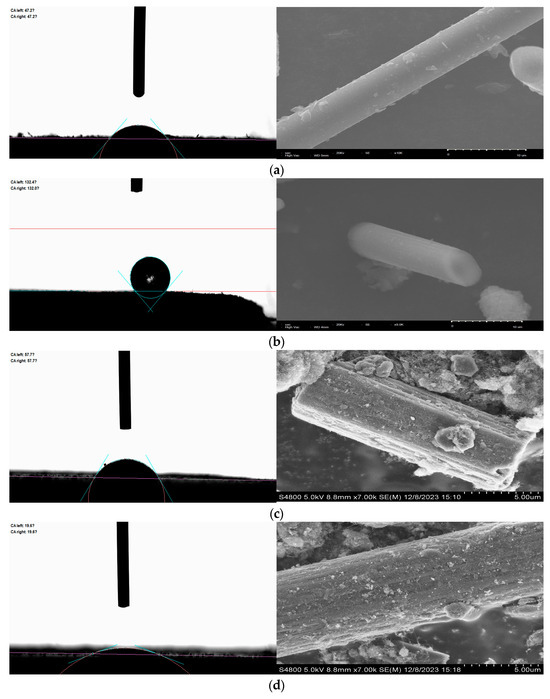
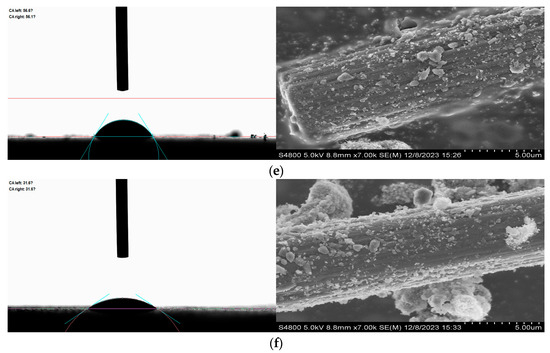
Figure 2.
SEM images with contact angle of (a) original carbon fiber; (b) de-sized carbon fiber; (c) CF1; (d) CF2; (e) CF3; (f) CF4.
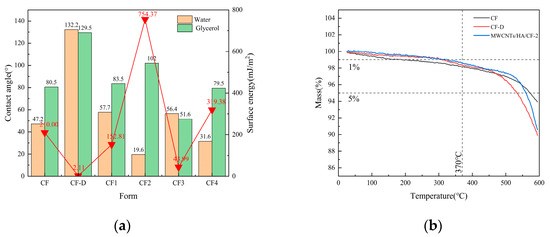
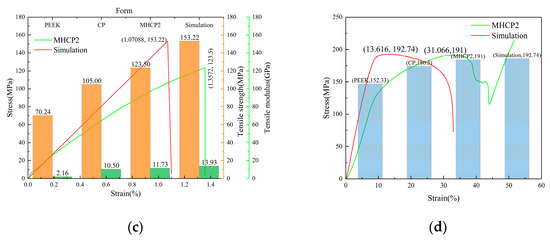
Figure 3.
Experimental curves and experimental data. (a) Contact angle and surface energy; (b) thermogravimetric analysis curves; (c) tensile curves and tensile test data; (d) compression curves and compression experimental data.

Table 2.
Calculation results for contact angle and surface energy of carbon fiber under different treatments.
3.1.2. Thermogravimetric Analysis
Since thermoplastic composites are usually molded at high temperatures, it is necessary to investigate the thermal resistance of several carbon fibers in the air. The results for the thermogravimetric tests of virgin carbon fibers, de-pulped carbon fibers, and CF2 in the air are shown in Figure 3b. When the weight loss mass reaches 1%, the resistance temperatures of CF, CF-D, and CF2 are 189.579 °C, 307.079 °C, and 324.579 °C, respectively; when the weight loss mass reaches 5%, the resistance temperatures of CF, CF-D, and CF2 are 572.079 °C, 532.079 °C, and 559.079 °C, respectively; and when the bearing temperature reaches the highest temperature of hot compression molding, at 370 °C, the weight losses of CF, CF-D, and CF2 are 1.85%, 1.62%, and 1.4%, respectively. It can be seen that CF2 exhibits the best heat-resistant properties. The optimal ratio identified in this research enhances the heat-resistant properties of the composite material, fully satisfying the requirements of hot compression molding.
3.2. Testing of Mechanical Properties of Composite Materials
3.2.1. Tensile Properties
Tensile tests were carried out on the pure carbon-fiber-reinforced polyetheretherketone composites and MWCNT/HA/CF/PEEK composites using an electronic universal material testing machine. The loading speed of the specimens was 2 mm/min, and the tensile properties of the MWCNT/HA/CF/PEEK composites represent the average data collected from the five specimens. The tensile properties are mainly characterized by tensile strength and tensile modulus. In particular, the tensile strength can be calculated using Equation (1):
The tensile modulus can be calculated using Equation (2):
According to the tensile sample dimensions, the analytical model in ANSYS can be modeled with a shell model, which is more simplified than a solid model. The length and width of the model are 180 mm and 20 mm, respectively, with 20 mm extended reinforcement sheet areas at the top and bottom ends for applying constraints and loads. In the resultant output, stress–strain curves are output by adding equivalent stresses and displacements. Fixed support (U1 = U2 = U3 = UR1 = UR2 = UR3 = 0) is applied to the lower-end stiffener region, and constraints (U1 = U2 = UR1 = UR2 = UR3 = 0) are applied to the upper-end stiffener region, whereby the translational degrees of freedom are retained in the z-direction only. In the analysis step, displacement loads are applied in the z-direction. Finite element analysis requires meshing of the model, and after meshing, dynamic display operations are performed using the ANSYS module.
The tensile test simulated damage that occurred at 0.05 s of the analysis step, and the stress–strain curve was calculated according to the established model, as shown in Figure 3c. The strength of MHCP2 obtained in the experiment was 123.5 MPa, which was 17.62% higher than the tensile strength of CP and 75.82% higher than that of pure PEEK. The elastic modulus of the MHCP2 composite was 11.73 GPa, which is close to the elastic modulus of human cortical bone, and the tensile strength of MHCP2 obtained from ANSYS simulation was 153.22 MPa, which is close to that of the test result at 123.5 MPa.
3.2.2. Compression Property
Compression tests were performed on the pure carbon-fiber-reinforced polyetheretherketone composites and MWCNT/HA/CF/PEEK composites. The electronic universal material testing machine was used to perform compression tests. The loading speed of the specimens was 2 mm/min. The compressive mechanical properties of the MWCNT/HA/CF/PEEK-2 composites represent the average value of the data collected from the five specimens. These properties were mainly characterized by the compressive strength of the composites, which can be calculated with Equation (3):
As shown in Figure 3d, the experimental strength of MHCP2 is 191 MPa, which is 5.82% higher than the compressive strength of CP and 25.39% higher than that of pure PEEK. The compressive strength of MHCP2 obtained from the ANSYS simulation is 192.74 MPa, which is close to the experimental compressive strength of 191 MPa.
3.2.3. Density
In this study, the geometric method was chosen to determine the density of composite materials. Specimens sized 100 mm × 100 mm × 4 mm were selected. Through the determination and calculation of the five samples, the densities of both the MHCP2 composite specimen and pure PEEK were found to be 1.33 g/cm3. This density is closer to the overall performance of small, lightweight materials with excellent performance.
3.2.4. Friction and Wear Experiment
According to the “Test Method for Sliding Friction and Wear of Plastics”, a ring-block-type sliding friction and wear test was conducted using a friction and wear tester. In the test, a rotating steel ring and the MWCNT/HA/CF/PEEK composite specimen block form the friction vice. The MWCNT/HA/CF/PEEK composite specimen had dimensions of 30 mm × 7 mm × 6 mm, with a working surface size of 30 mm × 7 mm. It underwent processing using a grinding machine to ensure surface flatness and roughness. The friction vice was made of quenched 45# steel, with heat-treated hardness between HRC40 and 45, a surface roughness (Ra) of not more than 0.4, and dimensions of Φ40 mm × Φ16 mm × 10 mm. The surface was also processed using a grinder. Both specimens and steel rings were cleaned with alcohol and dried for testing. The test conditions included a load of 196 N, a steel ring speed of 200 r/min, a test time of 2 h, and a test environment at room temperature under dry friction without a lubricating medium. The coefficient of friction obtained was 0.233, which is low and makes the material suitable for manufacturing friction components, such as the preparation of gears and bearings, and reduces energy loss and wear.
3.2.5. Contact Angle Test
The MWCNT/HA/CF/PEEK quaternary composites and original carbon-fiber-reinforced polyetheretherketone composites were selected and prepared as solid surfaces for contact angle experiments. A drop of deionized water was placed on the surface of each specimen, and the contact between the liquid and the solid surface was observed. The value of the contact angle was obtained by measuring the angle formed by the liquid surface at this contact point. The value of the contact angle is shown in Figure 4, which indicates that the contact angle of specimens prepared from the MWCNT/HA/CF/PEEK quaternary composites is 3.2° smaller than that of the original carbon-fiber-reinforced polyetheretherketone composites. If the contact angle is small, the liquid tends to spread more on the solid surface, which usually results in the liquid being more readily absorbed or expanded onto the solid surface. This property is essential in many fields, such as the study of cell–matrix interactions in biology. Hydrophilicity enables composites to be used more effectively in liquid environments; it enhances a material’s ability to resist fouling. For example, hydrophilicity allows a surface to come into easy contact with liquids, which aids in wetting, adsorption, and the transfer of liquids. Furthermore, hydrophilicity allows such materials to attach more water molecules, limiting the build-up of other contaminants and fouling on their surfaces. Using physical film-forming methods, such as condensation, and chemical film-forming methods, such as impregnation, to form a thin film layer of a certain thickness from MWCNT/HA/CF/PEEK tetrameric composite powders prevents surface fouling. It is suitable for applications that require long-term maintenance and cleaning.
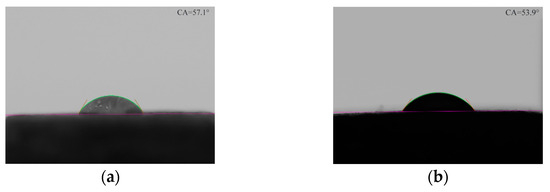
Figure 4.
Contact angles. (a) CF/PEEK; (b) MWCNT/HA/CF/PEEK.
4. Conclusions
To address the relatively low mechanical properties and elastic moduli of polyetheretherketone material, which can pose challenges for its application as bone prosthetics material, we prepared a multi-walled carbon nanotube/nanohydroxyapatite/carbon fiber ternary composite by using a wet blending technique, then examined its surface energy and thermal properties. We also prepared a multi-walled carbon nanotube/nanohydroxyapatite/carbon fiber/polyetheretherketone quaternary composite material using the ball mill blending technique and examined its mechanical properties and surface wettability. The following conclusions can be drawn:
- Due to the addition of multi-walled carbon nanotubes and nanohydroxyapatite, the surface energy of the ternary composites increases, the contact angle decreases, and the hydrophilicity is enhanced. The CF2 composites exhibited better heat resistance than the original carbon fibers. The de-sized carbon fibers were prepared to meet the requirements of the hot compression molding process. Additionally, the surface roughness of the carbon fiber in the CF2 composites increased.
- The MHCP2 composite tensile strength was 123.5 MPa, which was 17.62% higher than the CP tensile strength and 75.82% higher than pure PEEK. The MHCP2 elastic modulus was 11.73 GPa, which is close to that of human cortical bone. The compressive strength of the MHCP2 composite was 191 MPa, which was 5.82% higher than the compressive strength of CP and 25.39% higher than pure PEEK. Reducing the friction coefficient and density of the composite material can reduce energy loss and wear, resulting in characteristics such as light weight, high strength, and high elastic modulus. The hydrophilicity of the tetrameric composite material was improved, consequently leading to faster absorption or spreading of liquid onto the solid surface.
However, this study still experienced some limitations. The mechanical properties and elastic moduli of the quaternary composites are close to those of human skin and bone. However, the biocompatibility of quaternary composites has yet to be verified. The biocompatibility should be verified through experiments such as in vitro cell cultures, animal experiments, and biochemical analyses. If quaternary composites exhibit high biocompatibility, they can satisfy the requirements for use in implants. The MWCNTs/HA/CF/PEEK femur shank prosthesis tested in this study was prepared through hot compression molding technology. The MWCNTs/HA/CF/PEEK femur shank, along with a traditional titanium alloy femoral stem for the femoral prosthesis replacement simulation, was subjected to static, dynamic, and torsion loads, verifying the stability of the two materials prepared for the prosthetic replacement of the femoral stem. This research lays the foundation for the traditional bone prosthetics material.
Author Contributions
L.L. and Y.Z. conceived and designed the experiment; S.M. and S.Z. performed the experiment; S.M., S.Z., S.W., G.Y. and B.W. analyzed the data and prepared the manuscript. All authors have read and agreed to the published version of the manuscript.
Funding
This research was funded by the Youth Fund Project of the Science and Technology Research Project of Colleges and Universities in Hebei Province (QN2024222), the Natural Science Foundation of Hebei Province, the Beijing–Tianjin–Hebei Basic Research Cooperation Project (H2022208073), and the Hebei Provincial Department of Human Resources and Social Security, Hebei Province Three Talent Funding Project (B20221004).
Institutional Review Board Statement
Not applicable.
Informed Consent Statement
Not applicable.
Data Availability Statement
Data are contained within the article.
Conflicts of Interest
The authors declare no conflicts of interest.
References
- Mbogori, M.; Vaish, A.; Vaishya, R.; Haleem, A.; Javaid, M. Poly-Ether-Ether-Ketone (PEEK) in orthopaedic practice—A current concept review. J. Orthop. Res. 2022, 1, 3–7. [Google Scholar] [CrossRef]
- Singh, S.; Prakash, C.; Ramakrishna, S. 3D printing of polyether-ether-ketone for biomedical applications. Eur. Polym. J. 2019, 114, 234–248. [Google Scholar] [CrossRef]
- Lu, T.; Wen, J.; Qian, S.; Cao, H.L.; Ning, C.Q.; Pan, X.X.; Jiang, X.Q.; Liu, X.Y.; Chu, P.K. Enhanced osteointegration on tantalum-implanted polyetheretherketone surface with bone-like elastic modulus. Biomaterials 2015, 51, 173–183. [Google Scholar] [CrossRef] [PubMed]
- Häger, A.M.; Davies, M. Short-fibre reinforced, high-temperature resistant polymers for a wide field of tribological applications. J. Compos. Mater. 1993, 8, 107–157. [Google Scholar]
- Trivedi, D.N.; Rachchh, N.V. Graphene and its application in thermoplastic polymers as nano-filler—A review. Polymer 2022, 240, 124486. [Google Scholar] [CrossRef]
- Jeon, I.S.; Lee, M.H.; Choi, H.H.; Lee, S.; Chon, J.W.; Chung, D.J.; Park, J.H.; Jho, J.Y. Mechanical properties and bioactivity of Polyetheretherketone/Hydroxyapatite/Carbon fiber composite prepared by the mechanofusion process. Polymers 2021, 13, 1978. [Google Scholar] [CrossRef]
- Sun, Z.L.; Luo, Y.X.; Chen, C.Y.; Dong, Z.J.; Jiang, G.M.; Chen, F.X.; Ma, P.B. Mechanical Enhancement of Carbon Fiber-Reinforced Polymers: From Interfacial Regulating Strategies to Advanced Processing Technologies. Prog. Mater. Sci. 2023, 142, 101221. [Google Scholar] [CrossRef]
- Chen, Z.Y.; Chen, Y.; Ding, J.D.; Yu, L. Blending strategy to modify PEEK-based orthopedic implants. Compos. B Eng. 2023, 250, 110427. [Google Scholar] [CrossRef]
- Qin, W.; Li, Y.; Ma, J.; Liang, Q.; Tang, B. Mechanical properties and cytotoxicity of hierarchical carbon fiber-reinforced poly (ether-ether-ketone) composites used as implant materials. J. Mech. Behav. Biomed. Mater. 2019, 89, 227–233. [Google Scholar] [CrossRef]
- Zhou, Z.; Han, X.; Gao, W.J.; Li, Y.L.; Yu, W.Q.; Yang, S.H.; Zhang, J.J.; Wang, J.Y.; Shi, R.N.; Zhou, Y.M.; et al. Fabrication and mechanical properties of different types of carbon fiber reinforced polyetheretherketone: A comparative study. J. Mech. Behav. Biomed. Mater. 2022, 135, 105472. [Google Scholar] [CrossRef]
- Hassan, E.A.M.; Ge, D.T.; Yang, L.L.; Zhou, J.F.; Liu, M.X.; Yu, M.H.; Zhu, S. Highly boosting the interlaminar shear strength of CF/PEEK composites via introduction of PEKK onto activated CF. Compos. Part A Appl. Sci. Manuf. 2018, 112, 155–160. [Google Scholar] [CrossRef]
- Qin, W.; Xing, T.; Tang, B.; Chen, W.Y. Mechanical properties and osteogenesis of CFR-PEEK composite with interface strengthening by graphene oxide for implant application. J. Mech. Behav. Biomed. Mater. 2023, 148, 106222. [Google Scholar] [CrossRef] [PubMed]
- Zheng, Z.; Liu, P.J.; Zhang, X.M.; Xin, J.M.; Wang, Y.J.; Zou, X.S.; Mei, X.H.; Zhang, S.L.; Zhang, S.K. Strategies to improve bioactive and antibacterial properties of polyetheretherketone (PEEK) for use as orthopedic implants. Mater. Today Bio 2022, 16, 100402. [Google Scholar] [CrossRef] [PubMed]
- Liao, C.Z.; Li, Y.C.; Tjong, S.C. Polyetheretherketone and its composites for bone replacement and regeneration. Polymers 2020, 12, 2858. [Google Scholar] [CrossRef] [PubMed]
- Díez-Pascual, A.M.; Xu, C.P.; Luque, R. Development and characterization of novel poly (ether ether ketone)/ZnO bionanocomposites. J. Mater. Chem. B 2014, 2, 3065–3078. [Google Scholar] [CrossRef]
- Marathe, U.; Padhan, M.; Bijwe, J. Carbon nanotubes-a powerful nano-filler for enhancing the performance properties of polyetherketoneketone composites and adhesives. Compos. Sci. Technol. 2021, 210, 108813. [Google Scholar] [CrossRef]
- Han, W.Q.; Zhou, J.Y.; Shi, Q.H. Research progress on enhancement mechanism and mechanical properties of FRP composites reinforced with graphene and carbon nanotubes. Alex. Eng. J. 2023, 64, 541–579. [Google Scholar] [CrossRef]
- Khallaf, R.M.; Emam, A.N.; Mostafa, A.A.; Nassif, M.S.; Hussein, T.S. Strength and bioactivity of PEEK composites containing multiwalled carbon nanotubes and bioactive glass. J. Mech. Behav. Biomed. Mater. 2023, 144, 105964. [Google Scholar] [CrossRef]
- Puértolas, J.A.; Castro, M.; Morris, J.A.; Ríos, R.; Ansón-Casaos, A. Tribological and mechanical properties of graphene nanoplatelet/PEEK composites. Carbon 2019, 141, 107–122. [Google Scholar] [CrossRef]
- Yin, W.L.; Chen, M.; Bai, J.X.; Xu, Y.Z.; Wang, M.; Geng, D.C.; Pan, G.Q. Recent advances in orthopedic polyetheretherketone biomaterials: Material fabrication and biofunction establishment. Smart Mater. Med. 2022, 3, 20–36. [Google Scholar] [CrossRef]
- He, M.M.; Chen, X.C.; Guo, Z.J.; Qiu, X.T.; Yang, Y.T.; Su, C.L.; Jiang, N.; Li, Y.B.; Sun, D.; Zhang, L. Super tough graphene oxide reinforced polyetheretherketone for potential hard tissue repair applications. Compos. Sci. Technol. 2019, 174, 194–201. [Google Scholar] [CrossRef]
- Deng, Y.; Zhou, P.; Liu, X.C.; Wang, L.X.; Xiong, X.L.; Tang, Z.H.; Wei, J.; Wei, S.C. Preparation, characterization, cellular response and in vivo osseointegration of polyetheretherketone/nano-hydroxyapatite/carbon fiber ternary biocomposite. Colloids Surf. B 2015, 136, 64–73. [Google Scholar] [CrossRef] [PubMed]
- Cao, J.F.; Lu, Y.; Chen, H.C.; Zhang, L.F.; Xiong, C.D. Preparation and properties of multiwalled carbon nanotubes/hydroxyapatite/polyetheretherketone ternary nanocomplexes. Plast. Ind. 2018, 46, 113–116, 123. [Google Scholar]
Disclaimer/Publisher’s Note: The statements, opinions and data contained in all publications are solely those of the individual author(s) and contributor(s) and not of MDPI and/or the editor(s). MDPI and/or the editor(s) disclaim responsibility for any injury to people or property resulting from any ideas, methods, instructions or products referred to in the content. |
© 2024 by the authors. Licensee MDPI, Basel, Switzerland. This article is an open access article distributed under the terms and conditions of the Creative Commons Attribution (CC BY) license (https://creativecommons.org/licenses/by/4.0/).